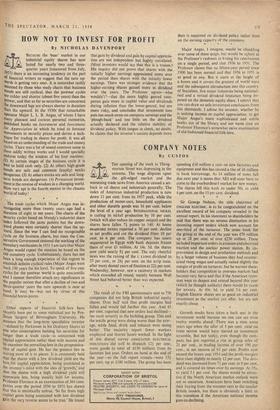HOW NOT TO INVEST FOR PROFIT
By NICHOLAS DAVENPORT BECAUSE the 'bear' market in our
industrial equity shares has now 411, lasted for nearly two and three-
quarter years (measured from July, 1955) there is an increasing tendency on the part of financial writers to suggest that the turn up- Wards is getting very near. It is somewhat rashly assumed by those who study charts that business trends are still cyclical, that the postwar cycles are milder and shorter (about five years) than the Prewar, and that as far as securities are concerned the downward legs are always shorter in duration than the upward. In the 1930s that remarkable operator Major L. L. B. Angas, of whom I have many pleasant and curious personal memories, Published books on Investment and Investment for Appreciation in which he tried to forecast Movements in security prices and devise a tech- nique for trading in shares for profit. It was all based on an understanding of the trade and money cycles. There was a lot of sound common sense in these oddly written works and I would specially endorse today the wisdom of his four maxims: (1) At certain stages of the business cycle it is best to hold cash only. (2) At others high-grade bonds are safe and common (equity) stocks dangerous. (3) At others stocks are safe and long- term bonds are dangerous. (4) Permanent invest- ment is the reverse of wisdom in a changing world. How very apt is the fourth maxim in the chaotic World of today!
* * *
The trade cycles which Major Angas was in- vestigating more than twenty years ago had a duration of eight to ten years. The charts of the security cycles based on Moody's industrial share Index followed the same pattern but the down- Ward phases were certainly shorter than the up- Ward. Since the war I can find no recognisable Cycle on the business charts, but since the Con- servative Government restored the working of the monetary mechanism in 1951 I am sure that Major Angas would repeat the maxims he based on the old monetary cycle. Unfortunately, there has not been a long enough experience of this regime to establish definite cyclical rules (Major Angas went back 130 years for his lore). To speak of five-year cycles for the postwar world is quite unscientific and I cannot therefore attach any significance to the popular notion that after a decline of two and three-quarter years the turn upwards is near at hand. It may be—but not by virtue of this financial hocus-pocus.
* * * Other aspects of financial folk-lore have recently been put to some statistical test by Pro- fessor Sargent of Birmingham University. He assumes that the long-term speculative investor
defined by Parkinson in his Ordinary Shares as one who contemplates holding his securities for longer than a trade cycle—is concerned with capital appreciation rather than with income and he examines the prevailing lore in the prognostica- tion of capital gain. He has the greatest fun in tearing most of it to pieces. It is commonly held that the shares with a low dividend yield are the best for capital appreciation, being associated in the investor's mind with the idea of 'growth,' and that the shares with a high dividend yield will appreciate less, being usually held for income. Professor Florence in an examination of 304 com- panies over the period 1936 to 1951 has shown that this is statistically untrue. 'So far from high capital gains being associated with low dividend Sam the very reverse seems to be true.' He found
that gain by dividend and gain by capital apprecia- tion are not independent but highly correlated. (Most investors would say that this is a truism.) His inquiry did not prove that shares with the initially higher earnings appreciated more over the period than shares with the initially lower earnings. There was stronger evidence that the higher-earning shares gained more in dividend over the years. The Professor agrees—who wouldn't?—that the more highly geared com- panies gain more in capital value and dividends during inflation than the lower-geared, but are more risky, and concludes that investment lore puts too much stress on company earnings and the 'plough-back' and too little on the dividend actually declared and the relative stability of dividend policy. With tongue in cheek, no doubt, he claims that the investor's success depends more than is supposed on dividend policy rather than on the earning capacity of the company.
Major Angas, I imagine, would be chuckling over some of these quips, but would be aghast at the Professor's rashness in blsing his conclusions on a single period, and that 1936 to 1951. The Professor claims that no fifteen-year period since • 1900 has been normal and that 1936 to 1951 is as good as any. But it starts at the height of a boom and it covers the greatest of world wars and the subsequent introduction into this country of Socialism, five major industries being national- ised and a virtual dividend limitation being im- posed on the domestic equity share. 1 submit that you can draw no safe investment conclusions from this shemozzle. I advise the investor, whether he is seeking income or capital appreciation. to get Major Angas's more sophisticated and subtle books out of the library and not waste time on Professor Florence's somewhat naive examination of old-fashioned financial folk-lore.


































 Previous page
Previous page